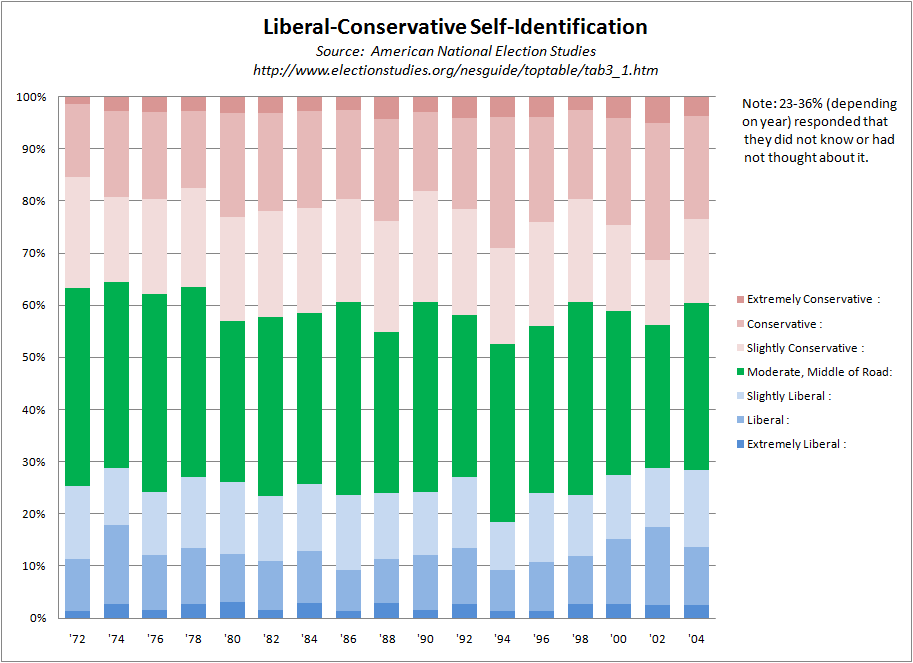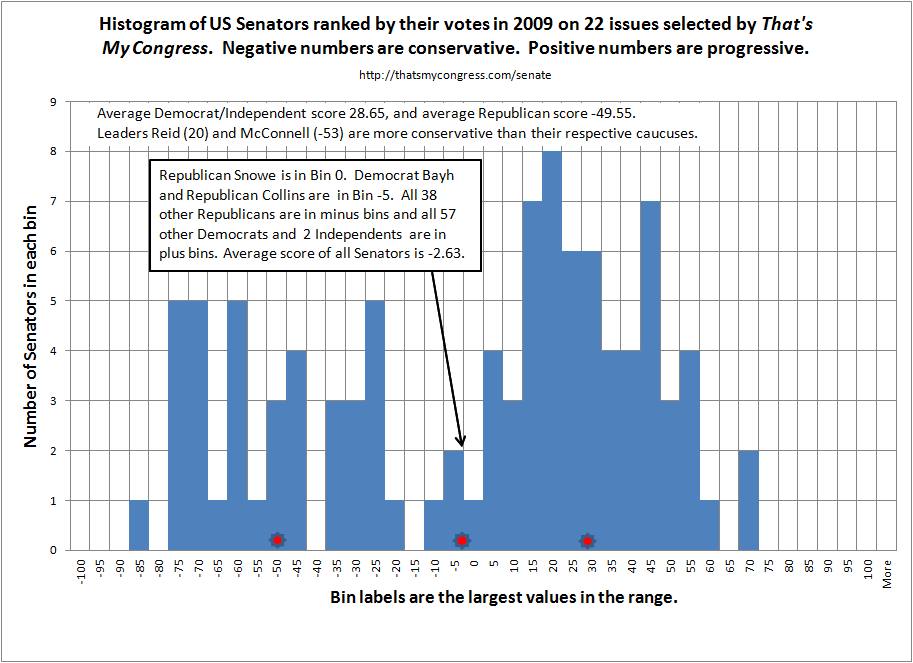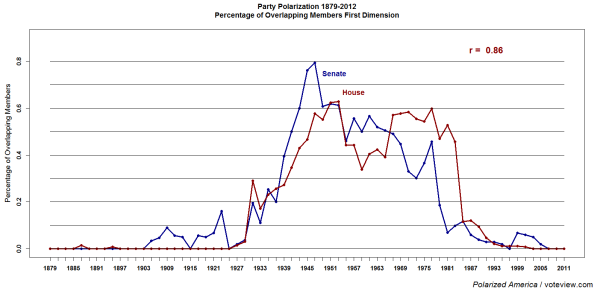Pundits and politicians, especially conservative ones, frequently tell us that the American electorate is "center-right" and that, therefore, liberal approaches to government policy cannot find favor with the electorate or pass Congress. Every policy must have a conservative flavor, we're told. The latest such pronouncement to come to my attention was by Jonah Goldberg here:
America is, quite simply, a center-right country. Many have cited polling data showing that self-described conservatives outnumber liberals 2 to 1. But that's not nearly so telling as the fact that self-identified conservatives have outnumbered liberals in every year since 1968; when combined with self-proclaimed moderates, the country is enduringly 65% to 75% moderates and conservatives.
I set out to find out if that's true and, if it is, whether one can make any useful inferences about what policies are supported and opposed by majorities of the electorate. I found it is true that self-described conservatives have outnumbered self-described liberals in every election year since at least 1970. But I found that when polled on specific policy questions likely voters were apt to skew liberal instead of conservative. In other words, respondents' self-described ideology is useless in predicting public attitudes toward specific policy issues.
The American National Election Studies, a collaboration of Stanford University and University of Michigan, has a wide array of interesting polling data from 1972 to 2004, including this on how respondents self-identify on the political spectrum. (There was no survey in 2006 and I don't have 2008 data.) [ADD 4/12/2011: The 2008 data have been posted, showing to my eye no significant change from 2004. The direct link to that table is here.]

See the long term trend? Me neither. Excluding the 23-36% of respondents who said they did not know or had not thought about an answer to the question, self-described Liberals have been 18-28% of the population, self-described Conservatives 36-47%, and self-described Moderates 28-38%. There are fluctuations from year to year, but no long-term trend that I can see. Regrettably, there are no comparable data for the 1960s, when Congress gave us civil rights legislation, Medicare, the War on Poverty, and other landmark liberal programs. However, virtually the entire body of federal environmental legislation, another liberal cause, was enacted in the 1970s. So, clearly an electorate that is 37-38% Conservative and only 24-28% Liberal does not preclude very liberal activity in Congress.
And this seeming paradox was still true in 2008 and 2009, as described here on Sabato's Crystal Ball.
In the 2008 ANES, for example, 42 percent of Americans placed themselves on the conservative side of the 7-point ideology scale while only 28 percent placed themselves on the liberal side. But in the same survey, 51 percent of Americans placed themselves on the liberal side of a similar 7-point scale measuring support for government-sponsored health insurance while only 37 percent placed themselves on the conservative side. More recently, a CBS/New York Times Poll in September 2009 found that almost two-thirds of Americans supported a government-run insurance option as part of a plan to reform health care in the U.S. It is findings like this that have led some liberal political commentators to argue that the United States is now a center-left nation.
Moreover, the article reports, it wasn't just healthcare on which likely voters skewed liberal.
When asked in an October 2008 Time Magazine poll about their views on specific policy issues, however, these likely voters took the liberal side more often than they took the conservative side. On six of ten issues–abortion, health insurance, the war in Iraq, regulation of financial institutions, government assistance to homeowners threatened by foreclosure and global warming–a majority or plurality of respondents came down on the liberal side. On three issues–gay marriage, offshore drilling, and business tax cuts–a majority or plurality of respondents came down on the conservative side. On one issue, federal bailouts for financial institutions, it was not possible to identify liberal and conservative positions.
Opinions on seven of the ten policy issues were correlated strongly enough that it was possible to combine them into a liberal-conservative issues scale. The issues included in the scale were abortion, gay marriage, health insurance, offshore drilling, global warming, the war in Iraq, and regulation of financial institutions. Scores on this scale ranged from 0 for those who took the most conservative position on all seven issues to 70 for those who took the most liberal position on all seven issues. . . .
 So on these issues, likely voters skewed distinctly liberal. Notice also, that the distribution of opinions seems to be roughly normal, i.e., concentrated in the middle and not polarized. To pass legislation on these issues then, it seems, Congress should craft center-left solutions—not center-right ones. Regrettably, attitudes and preferences among Members of Congress are not normally distributed but are highly polarized. Here is the bimodal distribution of Senators' 2009 votes, from this earlier post.
So on these issues, likely voters skewed distinctly liberal. Notice also, that the distribution of opinions seems to be roughly normal, i.e., concentrated in the middle and not polarized. To pass legislation on these issues then, it seems, Congress should craft center-left solutions—not center-right ones. Regrettably, attitudes and preferences among Members of Congress are not normally distributed but are highly polarized. Here is the bimodal distribution of Senators' 2009 votes, from this earlier post.

 Skeptic
Skeptic
